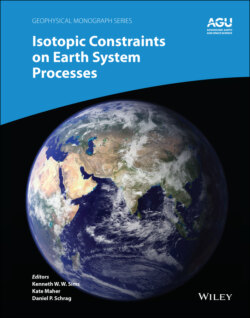Читать книгу Isotopic Constraints on Earth System Processes - Группа авторов - Страница 39
1.6.2. Rayleigh Fractionation
ОглавлениеThe kinetic isotope fractionation factor α ij is the key parameter for calculating the isotopic evolution of vacuum evaporation residues as a function of the amount of the parent element evaporated when diffusion in the residue was sufficiently fast to continuously homogenize the residue. To arrive at this formulation as a form of Rayleigh fractionation consider the mass conservation equation of a uniformly distributed isotope i in a volume V bounded by a surface of area A, which is dNi /dt =−Ji A, where Ni is the total atoms of isotope i in V. A similar conservation equation applies for isotope j. Taking the ratio of the two conservation equations and using equation 1.11 for the ratio of flux gives
(1.12)
which when rearranged becomes
(1.13)
Integrating equation 1.13 from an initial state with isotopic abundances Ni, o and Nj, o to a later state when the abundances have become Ni and Nj gives
(1.14)
Applying the exponential function to both sides of this equation it becomes , which dividing by and rearranging gives . Writing the isotope ratios as as Ri, j and as Ro one arrives at the Rayleigh fractionation equation for the evaporation residue
(1.15)
where . This Rayleigh equation states that the isotopic ratio of a continuously homogenized condensed phase with initial ratio Ro becomes Ri, jwhen a fraction f of the initial amount of isotope j remains in the residue (or when a fraction 1–f had evaporated). In most practical application one can replace by the fraction of the parent element remaining in the residue. Equation 1.15 shows that given an experimentally determined value of α ij and the degree of isotopic fractionation of an evaporation residue one can calculate how much of the parent element evaporated (i.e., 1–f).
